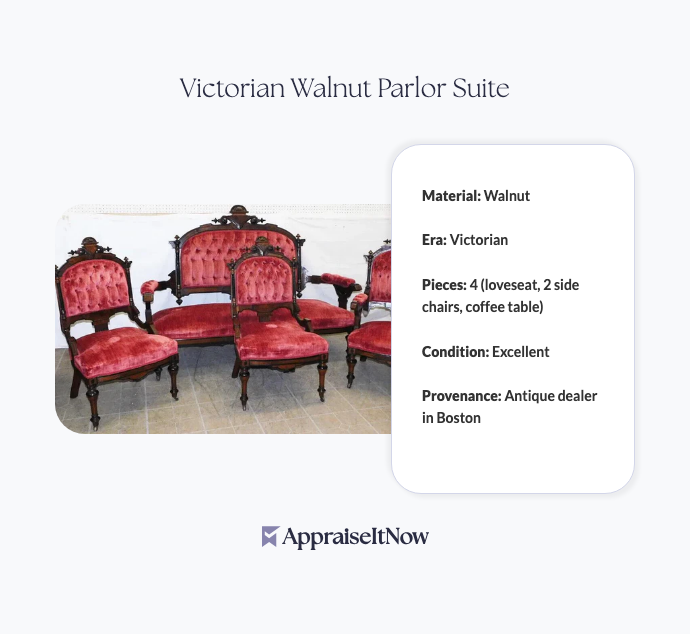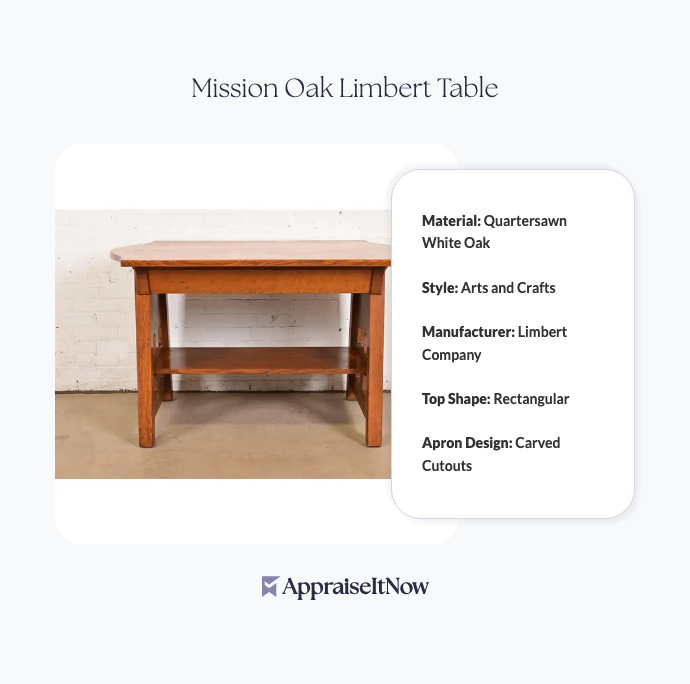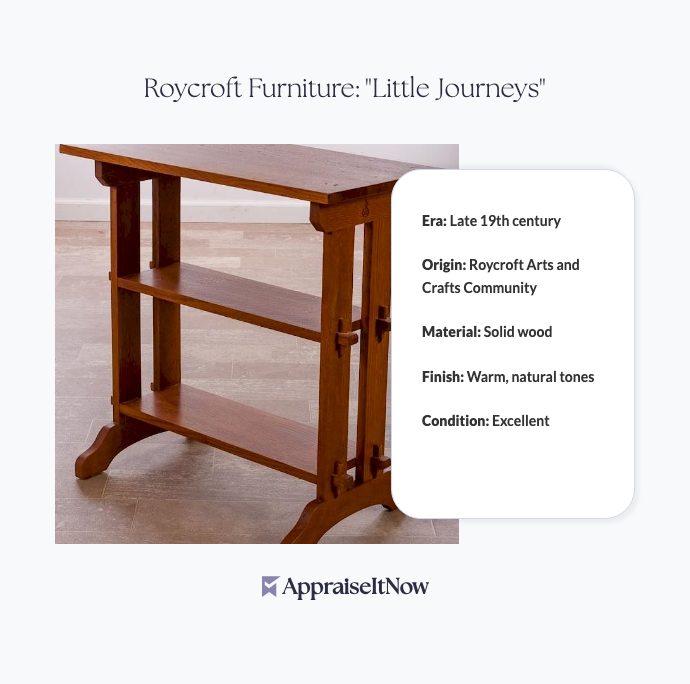<h1>How to Get Your Victorian Walnut Parlor Suite Appraised</h1>
<p>The Victorian Walnut Parlor Suite represents a significant investment in 19th-century craftsmanship, with quality examples currently valued between <strong>$5,000 and $7,000</strong> in today's market. Whether you're preparing for insurance coverage, estate planning, or a potential sale, understanding how to properly appraise this antique furniture ensures you receive an accurate valuation that reflects both its historical significance and current market demand.</p>
<h2>Understanding Your Victorian Parlor Suite's Value Drivers</h2>
<p>Your Victorian Walnut Parlor Suite's worth depends on several interconnected factors that professional appraisers evaluate systematically. The suite typically includes a loveseat, two side chairs, and a coffee table—each piece crafted from high-quality walnut with hand-carved ornamental details that showcase mid-to-late 19th-century artistry. These elements combine to establish value, but not all Victorian parlor suites command equal prices.</p>
<p>The maker's reputation significantly impacts your suite's appraisal value. Documented pieces from established Boston-area manufacturers or renowned furniture makers typically command 25-40% premiums over unmarked examples. When considering <a href="/types/antique-furniture">antique furniture</a> appraisals, provenance becomes your strongest asset—verified origin documentation distinguishes museum-quality pieces from reproduction-era furniture.</p>
<p>Condition tells the real story of value. Your parlor suite's original finish, the integrity of hand-carved details, and the structural soundness of cabriole legs and decorative flourishes all factor into professional valuations. The warm walnut patina that develops over 150+ years is often more desirable to collectors than refinished examples, as original surfaces preserve historical authenticity. Learn more about <a href="/blog/decoding-the-value-of-antique-furniture-materials-craftsmanship-and-historical-context">decoding furniture value</a> through materials and craftsmanship assessment.</p>
<div class="callout tip"><p><strong>Pro Tip</strong></p>
<p>Pieces first introduced in the 1860s command higher values than later Victorian reproductions, so original manufacture dates significantly affect your suite's appraisal.</p></div>
<h2>How Restoration and Reupholstery Impact Resale Values</h2>
<p>One of the most misunderstood aspects of Victorian furniture appraisal concerns restoration and reupholstery decisions. If you're considering updates to your parlor suite, understanding how these modifications affect market value should inform your choices.</p>
<p>Professional appraisers typically value original upholstery more highly than reupholstered examples, even when restoration is expert-quality. A parlor suite in original condition with worn Victorian-era fabric might appraise higher than the same suite with beautiful new upholstery, because collectors often prefer authentic materials that document the piece's history. However, structural repairs and cleaning actually enhance value—replacing broken springs, reinforcing loose joints, or removing accumulated grime improves both function and desirability without compromising authenticity.</p>
<p>The distinction matters significantly for insurance and resale purposes. A conservatively restored parlor suite (structural repair only) maintains or increases value, while cosmetic reupholstering can reduce appraisal value by 15-20% depending on the replacement fabric chosen. Conversely, <a href="/blog/how-to-increase-the-value-of-your-antique-furniture">professional conservation</a> following museum standards can add 10-15% to documented restoration work.</p>
<div class="callout note"><p><strong>Market Insight</strong></p>
<p>Buyers specifically seeking authentic Victorian interiors often prefer original upholstery and finishes, even in worn condition, over modern restorations.</p></div>
<h2>Valuation Methods: From Photo-Based to In-Person Assessment</h2>
<p>If you're wondering whether online appraisals accurately value your Victorian Walnut Parlor Suite compared to in-person inspections, the answer involves understanding what each method can and cannot accomplish.</p>
<p>Photo-based appraisals through platforms like <strong>AppraiseItNow</strong> provide preliminary valuations using high-quality photographs, detailed descriptions, and historical research. This method works well for establishing insurance estimates or gaining quick market insights. However, trained appraisers examining photographs cannot assess certain value-critical factors: the exact finish quality under varied lighting, structural integrity details only apparent through physical inspection, wood grain patterns that distinguish original wood from period repairs, or subtle condition issues affecting long-term stability.</p>
<p>In-person inspections by certified appraisers—particularly those credentialed through <strong>ASA, ISA, or AAA</strong> programs—provide comprehensive evaluations that photo-based assessments cannot match. During a physical inspection, your appraiser can:</p>
<ul>
<li>Examine wood grain, patina, and surface condition under controlled lighting</li>
<li>Test structural soundness by gently manipulating joints and supports</li>
<li>Identify wood species, construction techniques, and maker's marks</li>
<li>Document any repairs, replacements, or modifications</li>
<li>Assess original hardware and decorative elements</li>
<li>Create detailed condition photographs for insurance documentation</li>
</ul>
<p>For Victorian parlor suites valued between $5,000-$7,000, many collectors and insurance companies request in-person appraisals to justify the investment value. This approach particularly benefits estate planning, insurance coverage, or contested valuations where documentation standards matter professionally.</p>
<div class="callout tip"><p><strong>Professional Standard</strong></p>
<p>USPAP-compliant appraisals for antique furniture typically cost $300-$800 depending on complexity, but provide legally defensible valuations accepted by courts, insurance companies, and financial institutions.</p></div>
<h2>Documentation That Strengthens Your Appraisal</h2>
<p>Gathering proper documentation before seeking professional appraisal significantly improves accuracy and accelerates the valuation process. When appraising <a href="/types/personal-property">personal property</a> like Victorian parlor suites, comprehensive documentation translates directly to higher, more defensible valuations.</p>
<p>Start with measurements and photographs. Professional appraisers need front, side, and detail images showing carved elements, hardware, maker's marks, and condition issues. Include measurements of overall dimensions, seat heights, and piece-by-piece specifications. These details help appraisers locate comparable sales and establish market context.</p>
<p>Historical documentation strengthens your suite's narrative and value. Any receipts, auction house estimates, previous appraisals, or family provenance records establish ownership history. For Boston-verified pieces, this regional documentation often adds significant value—documented Boston manufacturing commands premium prices in New England markets and among serious collectors of <a href="/types/household-goods">household goods</a> and period interiors.</p>
<p>Condition notes matter tremendously. Document existing damage, repairs, or modifications honestly. Professional appraisers prefer complete transparency because it allows them to adjust valuations appropriately—attempting to hide condition issues typically results in lower final appraisals when discovered during inspection.</p>
<h2>Market Trends and Current Demand for Victorian Furniture</h2>
<p>The Victorian furniture market has experienced interesting fluctuations over the past decade, with walnut parlor suites maintaining relatively stable values compared to other antique categories. Understanding current demand helps contextualize your suite's $5,000-$7,000 valuation range.</p>
<p>Victorian aesthetics have resurged in popularity as interior design trends cycle back toward ornamental and historically-inspired furnishings. This renewed interest particularly benefits well-preserved parlor suites that complement traditional or eclectic living room designs. The market currently favors original, authentic pieces over reproductions—an important distinction affecting valuations.</p>
<p>Regionally, demand varies significantly. New England and Mid-Atlantic markets show stronger Victorian furniture appreciation than some Western regions, reflecting both collector density and historical preservation interests. Your appraiser should understand these regional variations, as they directly impact comparable sales analysis and fair market value determinations. For nuanced insights on <a href="/blog/understanding-the-value-of-antique-furniture-examining-quality-and-rarity">understanding furniture value</a>, professional appraisers track regional markets and auction results systematically.</p>
<p>Values should be updated every 2-3 years for insurance purposes, as market conditions evolve. A suite appraised at $6,000 five years ago might command $6,500-$7,000 today based on market appreciation, while changing styles could theoretically reduce values. Regular reappraisals ensure your insurance coverage remains adequate and your estate planning reflects current market conditions.</p>
<h2>Choosing the Right Appraiser for Your Parlor Suite</h2>
<p>Selecting a qualified appraiser requires attention to credentials and experience. The primary professional organizations—<strong>ASA (American Society of Appraisers), ISA (International Society of Appraisers), and AAA (American Association of Appraisers)</strong>—establish standards and require members to follow USPAP guidelines. When evaluating appraisers, prioritize those with:</p>
<ul>
<li>Specific experience appraising Victorian and antique <a href="/types/furniture">furniture</a></li>
<li>Published credentials and organizational memberships</li>
<li>USPAP compliance and insurance coverage</li>
<li>Track record with comparable sales and market research</li>
<li>Willingness to provide detailed written reports</li>
</ul>
<p>Your appraiser should explain their methodology, show you comparable sales justifying the valuation, and address your specific questions about value drivers. Many collectors benefit from <a href="/blog/how-to-choose-the-right-appraiser-for-your-furniture-appraisal">working with specialists</a> who dedicate significant practice time to decorative arts and period furniture.</p>
<p>AppraiseItNow connects you with credentialed specialists across the country who understand antique furniture valuation standards. Whether seeking photo-based estimates or arranging in-person inspections, professional appraisers provide documentation that withstands scrutiny for insurance, legal, or transactional purposes.</p>
<h2>Common Uses for Your Victorian Parlor Suite Appraisal</h2>
<p>Understanding why you need an appraisal helps you communicate requirements to your chosen appraiser. Insurance valuations require replacement cost assessments and comprehensive condition documentation. Estate planning appraisals establish fair market value for distribution or tax purposes, often requiring appraisals of all significant assets including <a href="/types/household-goods">household goods</a>. Sale preparation demands current market valuations that support asking prices to potential buyers.</p>
<p>Tax deduction scenarios, common when donating significant pieces to museums or historical societies, require independent appraisals establishing fair market value at the time of contribution. Divorce or contested asset divisions often require certified appraisals from neutral, credentialed experts acceptable to both parties and attorneys.</p>
<p>Each use case involves slightly different standards and documentation requirements, so communicate your specific purpose with your appraiser upfront. This transparency ensures the final report meets your intended use and provides legally defensible valuations.</p>
<h2>What to Expect from Your Appraisal Report</h2>
<p>A comprehensive USPAP-compliant appraisal report typically arrives within 2-3 weeks of the inspection appointment, depending on appraiser workload. The document should include detailed descriptions of each piece in your parlor suite, condition photographs, market analysis with comparable sales data, and a final value conclusion supported by your appraiser's reasoning.</p>
<p>Quality reports explain the methodology used—typically the sales comparison approach where similar pieces' recent sales establish market value ranges. Your report should document any limiting conditions, assumptions, and the scope of work performed. Professional appraisers review <a href="/blog/how-to-prepare-for-an-antique-furniture-appraisal">preparation steps</a> with clients to ensure optimal conditions and complete documentation.</p>
<p>The final report serves multiple purposes: insurance claim documentation, estate inventory records, sale preparation materials, or legal proceedings requiring professional valuation. Having certified appraisals accepted by major institutions and courts demonstrates professional standards and credibility.</p>
<h2>Summary</h2>
<p>Your Victorian Walnut Parlor Suite represents a meaningful financial and aesthetic asset deserving proper professional evaluation. Current market values between $5,000-$7,000 reflect both the craftsmanship inherent in 1860s-era walnut parlor suites and ongoing collector demand for authentic Victorian furnishings. Whether preparing for insurance coverage, estate planning, or preparing for sale, professional appraisers provide the expertise, documentation, and credibility that ensures accurate valuation and peace of mind.</p>
<div class="callout note"><p><strong>Key Takeaway</strong></p>
<p>A certified appraisal from a credentialed specialist gives you documented confidence in your Victorian Walnut Parlor Suite's value, provides legally defensible valuations for insurance and estate purposes, and ensures you understand this important piece's market position and long-term value trajectory.</p></div>







.avif)







